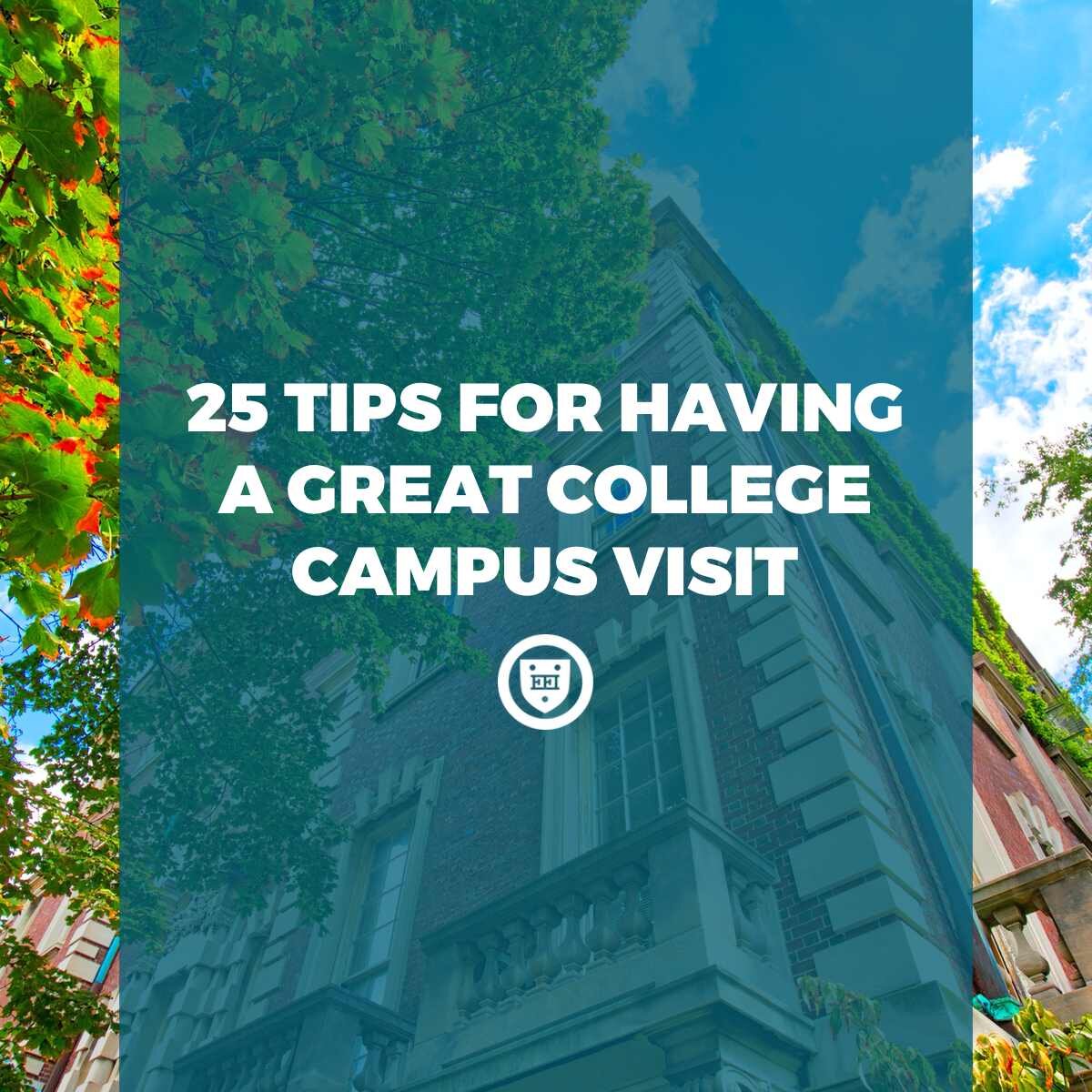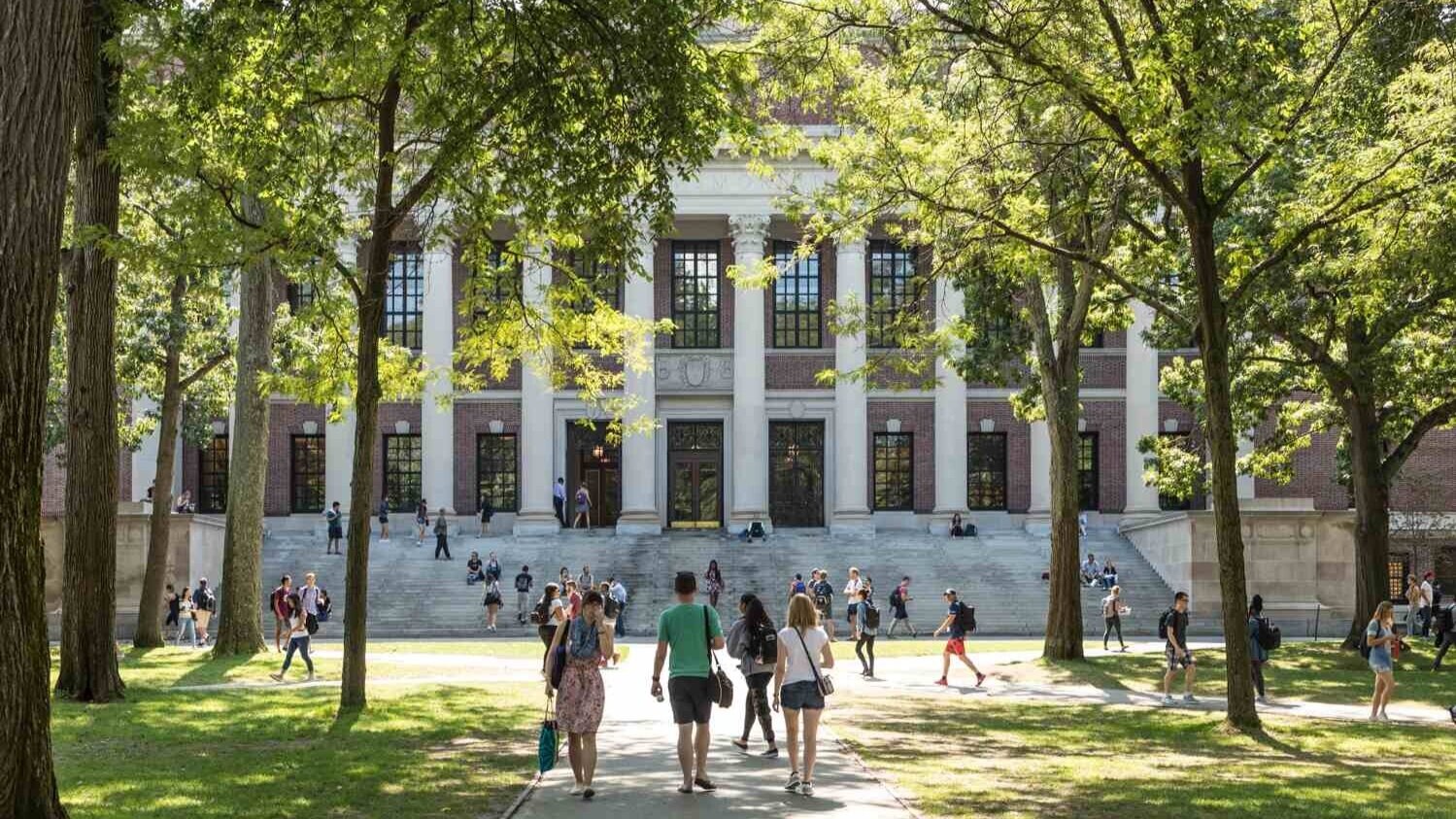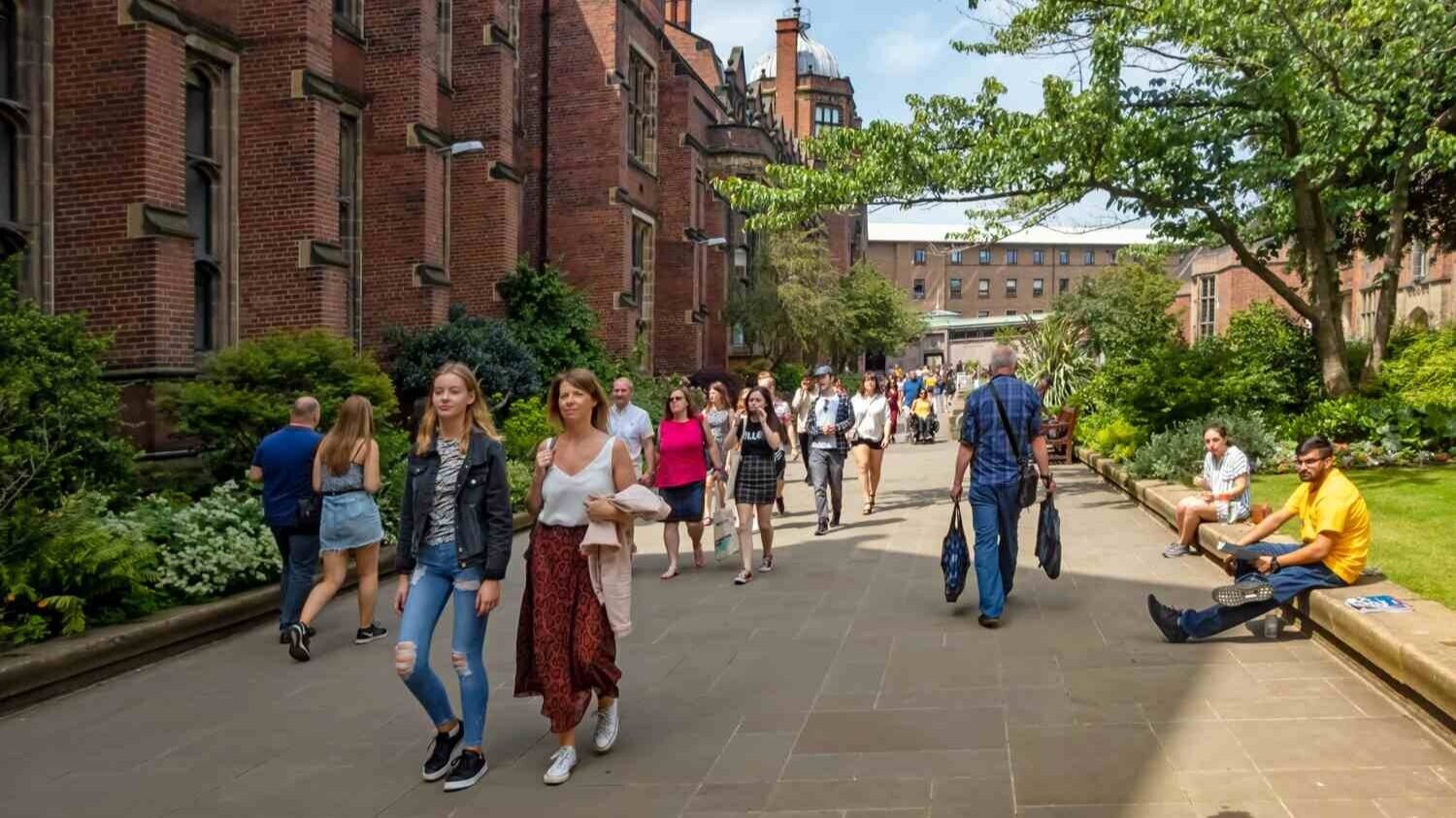25 Tips for Having a Great College Campus Visit
College campus visits are important for prospective college students for a number of reasons. For one, they demonstrate your interest in the schools to which you’re applying. Beyond this, they are useful in helping you and your family make the difficult decision of where you will invest your time, money, and efforts over the next four years of your life.
This is a big decision no doubt. When it comes to college visits, then, it’s no surprise that they can feel overwhelming. So here are 25 tips for how to have a great college visit that is smooth, informative, and even fun.
1. Visit during your junior year
It’s a good idea to visit a college campus or two in the few first years of high school (or even middle school). This can give you a feel early on for what the college experience is like and if it is for you. While this is certainly true, it is generally considered best to do the bulk of your campus visitations during your junior year. This is because much of your senior year will be spent working on actual college applications. So, getting your campus visits out of the way during junior year will leave you with plenty of time and energy to focus on those!
2. First, take virtual tours and/or attend a college fair
Before you even visit a college in person, narrow down your options by taking virtual campus tours online and, if possible, by attending a college fair. Of course, you can’t glean as much information from either of these experiences as you can from an in-person college visit. But you just might learn something about a school from either a virtual tour or college fair that could get it added to or taken off of your short list.
National College Fairs, for example, is a program of the National Association for College Admission Counseling (NACAC). It hosts college fairs across the country every year, including performing and visual arts college fairs, STEM college fairs, and an international universities fair. These fairs are free, and they give students the opportunity to engage with representatives from an array of colleges and universities across the globe.
For a searchable list of this year’s National College Fairs, please see this page from the NACAC website.
3. Go on a practice run
Before you visit the colleges in which you are most interested, start by visiting a school as a sort of practice run. This can be a local school that you feel less invested in or a school that you do not intend on applying to at all. The idea here is that with less at stake, you can get your nerves out in this “dress rehearsal” and then be confident to tackle those schools that are on the top of your list!
4. Visit during the school year
Although colleges might be less crowded over spring or winter break and you might have a bit more freedom to explore, chances are that many campus buildings will be closed during this time and there will be fewer people around. So, be sure to visit college campuses while school is in session—when you can see as much as possible and chat with as many people as possible, really getting a more accurate sense of how that college operates on a daily basis.
5. Sit in on an information session
College information sessions are short presentations run by admissions staff that give general facts about schools to prospective students and their families. These are typically held just before campus tours, and they are a great opportunity to get basic information about a college, including admission requirements, financial aid, and a bit about the undergraduate experience. Depending on the college, registration for these sessions may or may not be required. So, be sure to plan accordingly with each school. And, before you leave, be sure to get the business card of the admissions officer who led your session or (for larger schools) who is responsible for traveling to your local area, just in case you have any follow-up questions after your visit.
6. Take the official tour
Most colleges and universities hold daily tours of their campuses hosted by the admissions office. The guides who lead these tours are primarily current students working off of a script given to them by admissions. This means that they are told which campus sights to highlight and which attributes of the school to emphasize, which is a good thing since you will be sure to see the most iconic places on any given campus during your tour; yet, this doesn’t always mean that what is covered on the tour will necessarily interest you. So, be sure to ask to see locations that are of interest to you. Are you interested in acting classes but haven’t yet been taken by the theater building? Don’t be afraid to ask your guide. Also, don’t be afraid to ask questions that haven’t been addressed on the tour, even if they are more probing than where you can park without getting a ticket or find the best burger on campus. Remember that the purpose of these tours is to sell colleges to prospective students. So, your guide is there to help you in any way they can.
7. Then, take your own unguided tour
While it is important to take the official campus tour, it is also important to leave enough room in your schedule to take an unofficial tour on your own. Did you stop by any places on the guided tour that you wanted to revisit? Did you spot anything on the campus map that the official tour didn’t get to but that looked particularly interesting? Leaving time for your own unguided tour is also a great way to discover the ivy on the staircase of the science building, the view from the philosophy library, or the surprisingly good sandwiches in the student center coffee shop—those smaller and more charming things about a college campus that often make you fall in love with it.
8. Talk to as many people as possible
The most valuable resources when visiting any campus are the people you encounter there. And it’s important that you talk with a variety of these people—from existing students to faculty, staff, and even alumni (if possible). Combined, all of these individuals contribute to the life and vibe of a college campus, so they are all worth communicating with.
With that said, it’s worth noting that you can always walk up to students and other members of the campus community and initiate a conversation with them. But, they might be busy or otherwise unwilling to chat. So, you might consider working with the admissions office, who can connect you with relevant people who are willing to chat in person during your visit or via email/Skype.
9. Visit academic departments
Visit academic departments of which you expect to be a part, especially those you anticipate majoring or minoring in. Professors are typically happy to meet with prospective students. Just remember that they are generally very busy. So, before you arrive, make arrangements to meet with them, as they can provide you with detailed information about their programs, including syllabi from courses you would be required to take or interested in taking.
10. Visit other departments of special interest
In addition to academic departments, also be sure to visit any departments or organizations that are of special interest to you (such as athletic departments or student clubs) and speak to people there (such as athletic directors or club leaders). As with professors, you’ll typically find that most people enjoy meeting with prospective students to discuss their shared interests, so don’t be shy about reaching out to arrange these conversations. Just be sure to do so well enough in advance.
11. Visit a dorm (or two)
While a stop inside a student dorm in typically included on most official campus tours, don’t be afraid to ask to see multiple dorms on your tour, as student housing tends to vary. There is usually a separate dorm for first-year students, for instance. Often times campuses have more apartment-style housing for students in their third and fourth years, as well. Be sure to also check out these housing options for upperclassmen, so that you can know what to expect if you live on campus beyond your first year. And if you plan on living in the surrounding area instead of on campus, be sure to gather information about places for rent and ask students about their experiences with off-campus housing.
12. Visit other campus buildings you will likely frequent
For better or worse, much of a college student’s time outside of their classrooms and dorm is spent studying in other campus facilities such as the library and student center. While on your visit, be sure to visit these spaces. While in the library, walk through the stacks, check out the communal computer and quiet study areas, and even chat with a librarian—perhaps about the stacks of your intended area of study. While walking through the student center, ask yourself if you can picture yourself there, getting a coffee in the morning or detoxing with friends after a long day. Does it seem inviting and comfortable?
Other buildings/areas of campus you might want to visit include:
The quad
The health center
Athletic and/or workout facilities
The book store
The career center
The counseling center
Research labs
The disability resource center
Parking facilities
13. Visit (and eat in!) one or more student dining facilities
One of the great tricks to enjoying college is learning the best places to eat on campus. So, be sure to ask about the preferred dining spots and try them out for yourself. Most colleges typically have at least one cafeteria-style dining hall where you can sit down for a meal, as well as more of a “greasy spoon” style eatery where you can grab a quick bite on the go. If possible, check out one of each. While on your tour, also scope out the vending machine options—both near classroom buildings and student housing. These can come in handy when you need a fast snack between classes or when most dining facilities have closed shop for the night.
14. Get information about campus safety/security
Although it’s a matter of campus life that we tend to consider less, the issue of safety is incredibly important. So, take some time to ask about this issue on your visit. Do all students on campus generally feel safe, even when walking to and from evening classes? Does the campus offer a student shuttle service? What measures does campus security take to enforce safety precautions? Do security personnel or members of local police have a presence on campus/regularly patrol campus?
15. Visit the surrounding area
In a way, when you commit to the University of Alabama, you’re not just committing to the University of Alabama; you’re also committing to the city of Tuscaloosa. When you commit to being a Trojan, you’re also committing to greater Los Angeles. This includes all of the local coffee shops, bookstores, restaurants, theaters, and everything else that each of these areas has to offer. So, be sure to leave some time to not only check out the college campus on your visit but to also check out the city or town in which the college is located, since you will be sure to engage with the life of that place, as well.
16. Meet with a member of both financial aid and admissions
Even if you’ve already sat in on the information session and have gone on the official campus tour, it’s a good idea to meet individually with both a member of the financial aid office and admissions. Finances can present a real barrier to entry for prospective college students, and figuring out how to receive aid in order to make college possible can simply be confusing. So, sitting down with a professional who can explain your options is incredibly beneficial.
And with so many prospective students applying to their institution every season, it’s important to admissions officers that you stand out from the crowd. Taking the time and effort to meet with an admissions officer during your campus visit allows them to put a face to a name once your application rolls in, ideally giving you a leg up from the other applicants in the stack.
17. Spend the night and/or sit in on a class
Many colleges allow you to briefly immerse yourself in the life of their school by spending the night with a current student and sitting in on a class session. While your host isn’t always responsible for entertaining you during your overnight stay, the experience can be a chance to experience the workings of a dorm, often including a communal living space and shared bathrooms. When you sit in on a class, take stock of your fellow students. Do they seem engaged? Also take stock of the classroom. Do the facilities seem up-to-date and well taken care of? Do you otherwise feel comfortable in the space?
18. Keep an eye out for campus literature
While in the admissions office, be sure to check out any available brochures and pamphlets. While these often include general information about a school that can be found on their website, they can be helpful in your college decision-making process since they are portable, handy, and easy to organize with the other college brochures and pamphlets you’ve accumulated. In addition to these, also keep your eyes peeled for pamphlets and other signs posted on bulletin boards across campus advertising upcoming events. And, if possible, get your hands on a copy of the school newspaper. What is the tone of this literature? Do the activities they boast sound interesting to you? Can you picture yourself taking part in them?
19. Don’t let the weather rain on your parade
Remember that once you’re enrolled at a school, you will be there relatively year-round, experiencing it in all the weather that area has to offer. So, if you happen to be taking your campus tour on a rainy day, be sure to do your best to not let it dampen your view of that school. Try to imagine what the campus will look like on a beautiful spring or summer day as well, with students taking in the sun and playing Frisbee on the quad.
20. Try to read the school’s vibe
As you walk around campus on your tour, do a good amount of people watching. How does the student body strike you? How do they seem to interact with one another? Is it what you envision when you dream about going to college? For instance, if the student body appears to lack diversity and you believe that you would thrive in a more diverse environment, this might not be the school for you. Or, if there hardly seems to be anyone on campus, and you know you would thrive in a more vibrant setting, this might not be the school for you either. Just think: Can you see yourself happily fitting in among these people and this environment?
21. Come prepared with questions
It can feel like a lot is being thrown at you at once during a college campus visit, and it can be easy in the moment to forget questions you want to ask. So, come prepared with questions either printed out or typed on the notes app of your phone. Have questions for everyone you’ll encounter, not just admission staff or your tour guide. And divide your questions into useful categories (such as by person or subject) so that they are more easily accessible as you make your way through the day.
Remember, too, to not get too bogged down with questions regarding logistics during your visit (e.g. the size of the student body, the typical class size, etc.). You can typically locate the answers to such questions on a college’s website or in their brochures. Instead, try to ask more questions about less tangible but no less important aspects of the college experience. A few such questions include:
What makes your school unique?
How would you describe the student body?
What sort of student would most thrive here/would not be happy here?
What’s something you wish you had known about this campus before coming here?
Does the college work to prepare its students for a career after study?
Do the professors seem happy here?
How do locals feel about the students here?
For a list of more questions to ask on a college visit, check out our article on 14 Insightful Questions to Ask College Admissions Officers.
22. Keep an open mind
While you may already have feelings about a certain college for one reason or another (e.g. your big sister went there, your favorite basketball player went there, or you’ve always heard about it in movies or on the news), try to walk into your campus visit without any preconceived notions—whether they be good or bad. Try to participate in all possible activities during your visit, even if they might be a bit out of your comfort zone or if you only guess they’ll be relevant to your future college experience. In the end, the more information you have about each school, the better decision you’ll be able to make about where you’ll attend college.
23. Take plenty of notes and photos
Don’t trust your campus visit to memory. Especially when you’re visiting multiple colleges, the information you’ve taken in can blend together. So, be sure to take notes about your impressions of each school. And take plenty of photos, as well—including selfies. Just think of how cool it will be to have a throwback photo of your first time visiting your alma mater!
For help with keeping notes during multiple college campus visits, check out this “College Comparison Worksheet” (PDF) from the NACAC website.
24. Follow up
Your college visit doesn’t end when you drive away from campus. An important step in the process is following up with the people with whom you met during your time on campus, especially professors and staff. These communications don’t have to be formal. In fact, emails are best since they are easiest to respond to. When drafting your follow-up emails, simply thank these individuals for their time and express that you had a positive experience during your visit. Another tip is to mention something specific from your visit (e.g. something you saw, did, or discussed together) to personalize your note and show how much you care.
Another important step post-campus visit involves looking back at your notes and photos; writing down any follow-up questions you might have; and discussing your impressions with family, friends, and trusted mentors. What are your thoughts after this reflection?
25. Enjoy yourself
Last (but certainly not least), remember to enjoy yourself while visiting college campuses. Of course, this is, in part, just a state of mind. But there are also practical steps that you can take to ensure that the campus visit experience is a pleasurable one. First, don’t try to fit in too many campus visits or even too much of one campus visit in on a single day. Also, perhaps leave some time for something fun while visiting a college, such as a nearby tourist attraction. And regardless of your itinerary, be sure to plan your campus visit reasonably well ahead of time to alleviate any stress that comes from being in a time-crunch.
Finally, remember that while choosing a college is a big decision, it is an exciting one that typically only comes once in a lifetime. So, be excited about the process!
Stacy G. is a writer and teacher who has taught composition, literature, and creative writing courses at a number of public and private universities across the U.S. She has also taught SAT, AP English, and Literature SAT Subject Test courses at Elite Prep. She likes poetry, dogs, and poetry about dogs.





